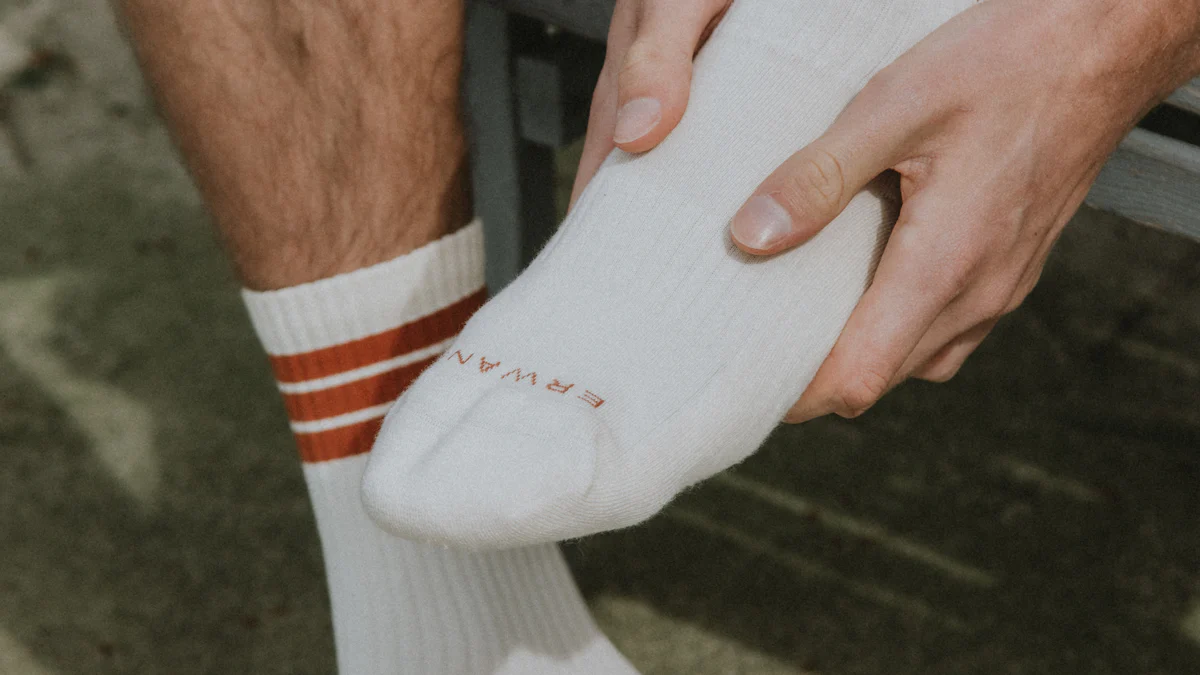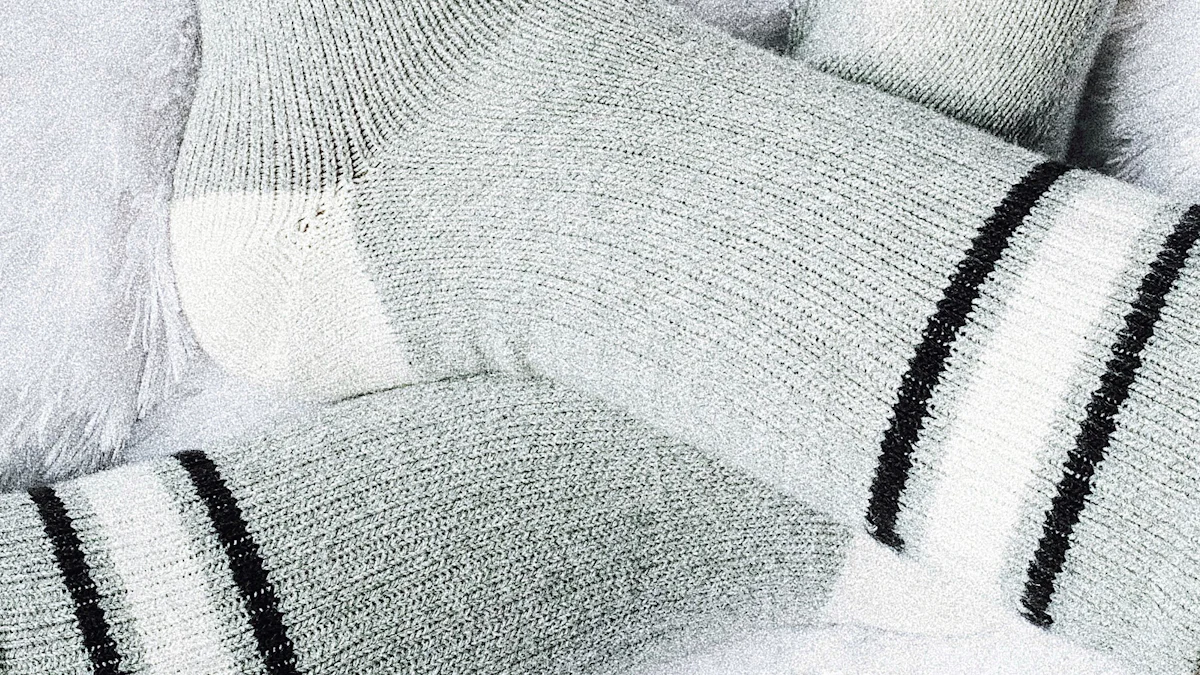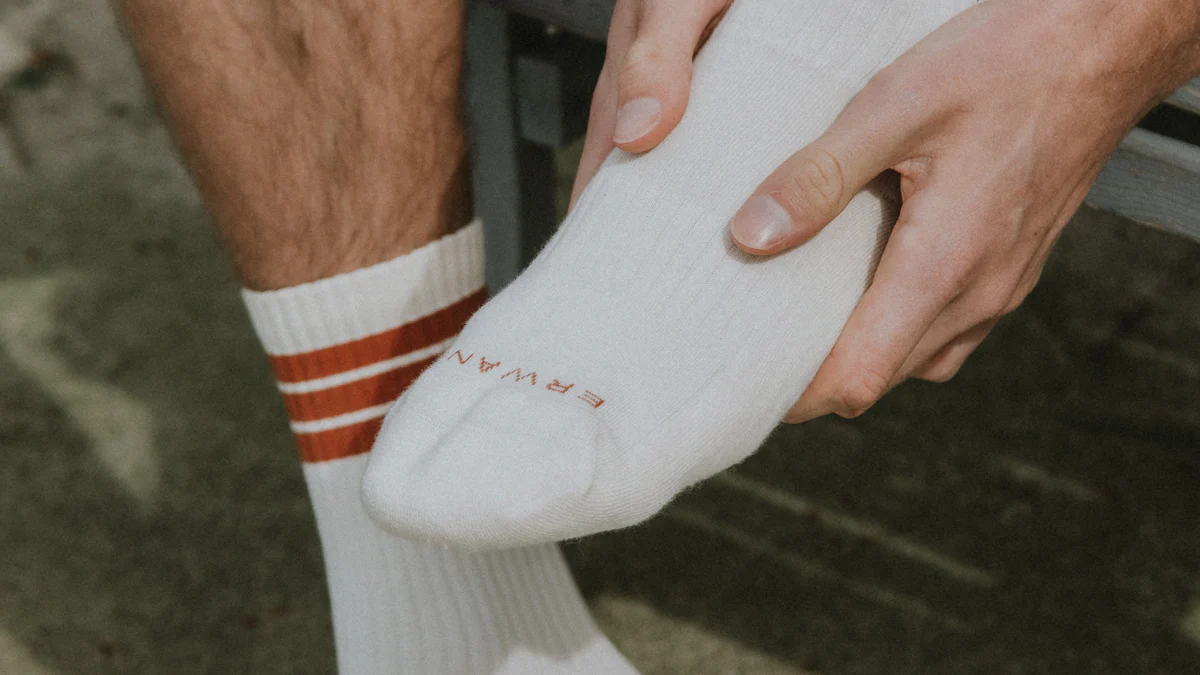
Proper foot care is crucial for individuals with diabetes and circulatory issues. Many people confuse diabetic compression socks with regular compression socks. This blog aims to compare and contrast these two types of socks.
Understanding Diabetic Socks

Features of Diabetic Socks
Material and Design
Diabetic compression socks use fine-textured fabrics like bamboo, wool, polyester, cotton, and lycra. These materials ensure comfort and durability. The design includes cushioned padding from toe to heel. This padding offers added protection and comfort for sensitive feet.
Moisture-Wicking Properties
Diabetic compression socks feature moisture-wicking materials. Wool, cotton, and synthetic blends keep feet dry. Dry feet reduce the risk of fungal infections and skin irritation. Moisture-wicking properties are crucial for maintaining foot health.
Seamless Construction
Diabetic compression socks have a seamless design. No seams along the toe reduce the risk of rubbing and blisters. Seamless construction ensures comfort and prevents skin irritation. This feature is essential for individuals with sensitive feet.
Intended Uses of Diabetic Socks
Prevention of Foot Ulcers
Diabetic compression socks help prevent foot ulcers. Cushioned padding and seamless design reduce pressure points. Proper circulation and dry feet decrease the risk of ulcers. Foot ulcers can lead to severe complications if not managed properly.
Reducing Risk of Infections
Diabetic compression socks reduce the risk of infections. Moisture-wicking materials keep feet dry. Dry feet prevent fungal and bacterial growth. Reduced infections contribute to overall foot health.
Enhancing Comfort for Sensitive Feet
Diabetic compression socks enhance comfort for sensitive feet. Fine-textured fabrics and cushioned padding provide a soft feel. Seamless construction prevents irritation. Comfortable socks improve daily activities and quality of life.
Benefits of Diabetic Socks
Improved Circulation
Diabetic compression socks improve circulation. Non-binding and stretchy materials promote healthy blood flow. Improved circulation reduces the risk of complications. Healthy blood flow is vital for foot health.
Protection from Blisters and Sores
Diabetic compression socks protect from blisters and sores. Seamless design and cushioned padding prevent friction. Moisture-wicking properties keep skin dry. Protection from blisters and sores is essential for individuals with diabetes.
Temperature Regulation
Diabetic compression socks regulate temperature. Fine-textured fabrics like wool and bamboo maintain a comfortable temperature. Temperature regulation prevents extreme cold or heat exposure. Proper temperature control is crucial for foot health.
Understanding Compression Socks

Features of Compression Socks
Graduated Compression
Compression socks provide graduated compression. The pressure is highest at the ankle and decreases towards the knee or thigh. This design promotes upward blood flow. Graduated compression helps prevent blood from pooling in the lower legs.
Material and Elasticity
Compression socks use elastic materials like spandex and nylon. These materials ensure a snug fit. Elasticity provides consistent pressure along the leg. The fabrics are also durable and breathable, enhancing comfort during wear.
Different Compression Levels
Compression socks come in various compression levels. Light compression ranges from 15-20 mmHg. Moderate compression ranges from 20-30 mmHg. High compression ranges from 30-40 mmHg. Different levels cater to specific medical needs and preferences.
Intended Uses of Compression Socks
Managing Swelling and Edema
Compression socks help manage swelling and edema. Graduated compression reduces fluid buildup in the legs. This feature benefits individuals with lymphedema and other conditions causing swelling. Consistent use can alleviate discomfort and improve mobility.
Enhancing Blood Flow
Compression socks enhance blood flow. The graduated pressure encourages circulation from the feet to the heart. Improved blood flow reduces the risk of blood clots. Enhanced circulation supports overall vascular health.
Support for Varicose Veins
Compression socks provide support for varicose veins. The pressure helps reduce vein diameter. This support alleviates pain and discomfort associated with varicose veins. Regular use can prevent the progression of vein issues.
Benefits of Compression Socks
Reduced Leg Fatigue
Compression socks reduce leg fatigue. The pressure supports muscles and improves circulation. Reduced fatigue benefits individuals who stand or sit for long periods. Athletes also experience less muscle soreness and quicker recovery.
Prevention of Deep Vein Thrombosis (DVT)
Compression socks help prevent Deep Vein Thrombosis (DVT). The graduated compression reduces the risk of blood clots forming in deep veins. This prevention is crucial for travelers and individuals with limited mobility. Consistent use can significantly lower DVT risk.
Improved Athletic Performance
Compression socks improve athletic performance. Enhanced blood flow delivers more oxygen to muscles. This improvement boosts endurance and reduces recovery time. Athletes benefit from better performance and reduced injury risk.
Choosing the Right Sock for Your Needs
Assessing Your Health Condition
Diabetes Management
Individuals with diabetes need to prioritize foot health. Diabetic compression socks offer specific features that cater to this need. These socks use fine-textured fabrics and seamless construction to prevent irritation. Moisture-wicking properties keep feet dry, reducing the risk of infections. Proper circulation is crucial for preventing complications like foot ulcers. Consult a healthcare professional before using any type of compression sock.
Circulatory Issues
People with circulatory issues benefit from wearing diabetic compression socks. These socks help manage conditions like swelling and edema. Graduated compression promotes upward blood flow, reducing fluid buildup in the legs. Consistent use can alleviate discomfort and improve mobility. Always consult a doctor to determine the appropriate compression level for your condition.
Consulting with Healthcare Professionals
Doctor’s Recommendations
Doctors play a vital role in recommending the right type of sock. Diabetic compression socks may not suit everyone. Some people with diabetes should avoid compression socks unless a doctor advises them. Compression socks could restrict blood flow and impede the healing process. Always seek medical advice to ensure the chosen sock meets your health needs.
Medical News Today states, “It may be advisable for people living with diabetes to avoid using compression socks unless a doctor recommends them as part of the treatment plan.”
Podiatrist’s Advice
Podiatrists specialize in foot health. A podiatrist can provide valuable insights into choosing between diabetic compression socks and regular compression socks. Podiatrists assess individual foot conditions and recommend the best options. Their advice ensures that the chosen sock offers maximum protection and comfort.
Practical Considerations
Daily Activities
Daily activities influence the choice of diabetic compression socks. People who stand or walk for long periods need socks that offer comfort and support. Moisture-wicking properties keep feet dry during physical activities. Seamless construction prevents blisters and sores, enhancing daily comfort.
Comfort and Fit
Comfort and fit are essential when selecting diabetic compression socks. Fine-textured fabrics like bamboo and wool ensure a soft feel. The snug fit provided by elastic materials offers consistent pressure. Proper fit reduces the risk of irritation and enhances overall comfort.
Cost and Availability
Cost and availability also play a role in choosing diabetic compression socks. These socks come in various price ranges, catering to different budgets. Availability in local stores and online platforms makes it easier to find the right pair. Investing in quality socks ensures long-term benefits for foot health.
Care and Maintenance of Socks
Washing and Drying Tips
Gentle Washing Techniques
Proper care extends the life of diabetic compression socks. Hand washing or using a gentle cycle on the washing machine helps maintain the fabric’s integrity. A mesh laundry bag can protect the socks during the wash. This method prevents excessive stretching and wear.
Avoiding High Heat
High heat can damage the elasticity of diabetic compression socks. Air drying is the best option to preserve their shape and function. Avoid using a dryer, as the heat can weaken the fibers. Place the socks in a well-ventilated area to dry naturally.
When to Replace Your Socks
Signs of Wear and Tear
Regular inspection of diabetic compression socks ensures they remain effective. Look for signs of wear such as thinning fabric, holes, or stretched-out elastic. These indicators mean the socks no longer provide the necessary support and protection.
Maintaining Effectiveness
Replacing diabetic compression socks every six months is advisable. Consistent use and washing can reduce their effectiveness over time. New socks ensure optimal moisture-wicking, cushioning, and compression. Regular replacement maintains foot health and comfort.
Tips for Healthy Feet
Regular Foot Inspections
Checking for Sores and Blisters
Daily foot inspections are crucial for individuals with diabetes. Check for sores, blisters, and any signs of irritation. Early detection helps prevent severe complications. Diabetic compression socks can aid in reducing friction and preventing blisters.
Monitoring Skin Changes
Monitor skin changes regularly. Look for discoloration, swelling, or unusual textures. These changes may indicate poor circulation or infection. Diabetic compression socks help maintain healthy blood flow, which supports skin health.
Proper Foot Hygiene
Daily Cleaning Routine
Maintain a daily cleaning routine. Wash feet with mild soap and warm water. Dry thoroughly, especially between the toes. Clean feet reduce the risk of infections. Diabetic compression socks keep feet dry throughout the day.
Moisturizing and Nail Care
Moisturize feet daily to prevent dryness and cracking. Use a non-greasy lotion. Trim nails straight across to avoid ingrown toenails. Proper nail care prevents injuries and infections. Diabetic compression socks provide added protection for well-maintained feet.
Footwear Choices
Choosing the Right Shoes
Select shoes that offer support and comfort. Ensure shoes have a wide toe box and cushioned insoles. Avoid high heels and tight-fitting shoes. Proper footwear reduces pressure on sensitive areas. Diabetic compression socks complement well-chosen shoes by providing additional cushioning.
Importance of Proper Fit
Ensure shoes fit properly. Ill-fitting shoes cause blisters, sores, and other foot problems. Measure feet regularly, as sizes can change over time. Diabetic compression socks enhance the fit of shoes by providing a snug yet comfortable feel.
Diabetic compression socks and regular compression socks serve distinct purposes. Diabetic compression socks cushion feet, reduce friction, and prevent blisters and ulcers. These socks also enhance circulation and keep feet dry. Regular compression socks improve blood flow, reduce swelling, and alleviate pain.
Choosing the right type of sock based on individual health needs is essential. People should consult healthcare professionals for personalized advice. Proper foot care contributes to overall health and well-being.
“Both diabetic and compression socks serve essential roles in medical foot care. However, their functions, designs, and benefits differ.”

